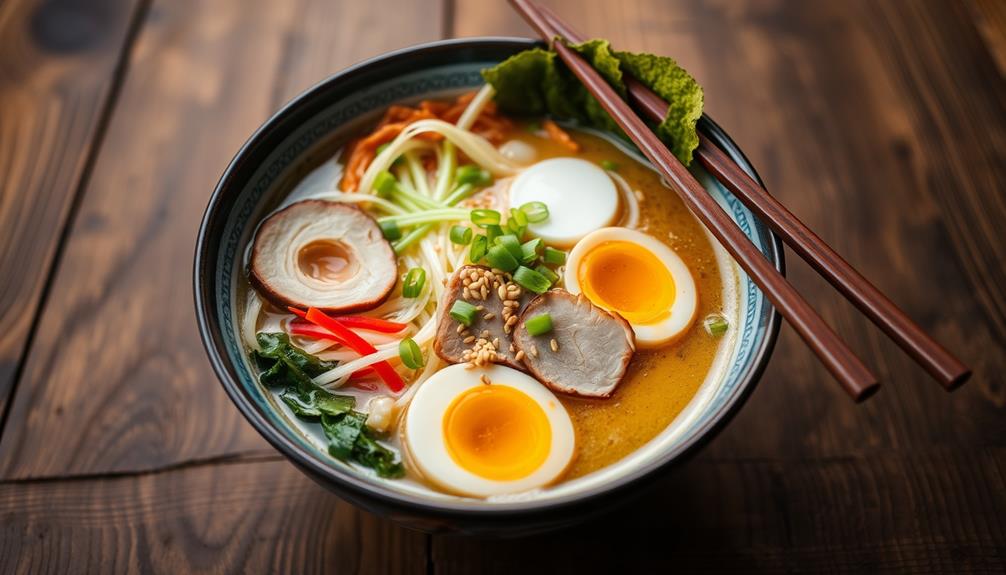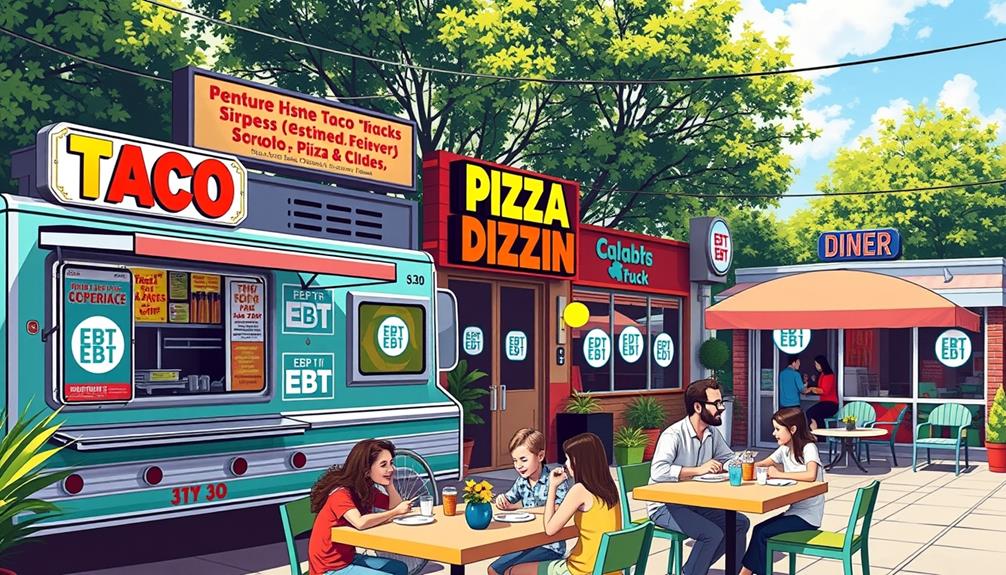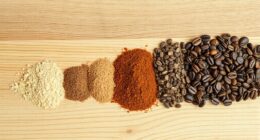Restaurant ramen can be a tasty yet tricky option for your health. A typical bowl contains around 450 to 600 calories, largely influenced by the broth type. High-sodium broths can exceed 1,760 mg per serving, raising your blood pressure risk. Ramen noodles are low in fiber and essential nutrients, so they lack a balanced profile. However, you can make healthier choices by opting for low-sodium broth and loading up on fresh veggies and lean proteins. Moderating your intake is key to enjoying ramen without adverse health effects. If you stick around, you'll discover even more tips for enjoying ramen healthily.
Key Takeaways
- Restaurant ramen can be high in calories, often ranging from 450 to 600 calories per bowl depending on the ingredients used.
- Many ramen broths exceed 1,760 mg of sodium per serving, increasing the risk of hypertension and heart disease.
- Opting for low-sodium broth and adding fresh vegetables can enhance nutritional value and reduce sodium intake.
- Pairing ramen with lean proteins like chicken or tofu can improve its healthiness and provide essential nutrients.
- Consuming restaurant ramen occasionally, rather than regularly, helps mitigate health risks associated with high sodium foods.
Caloric Content of Ramen
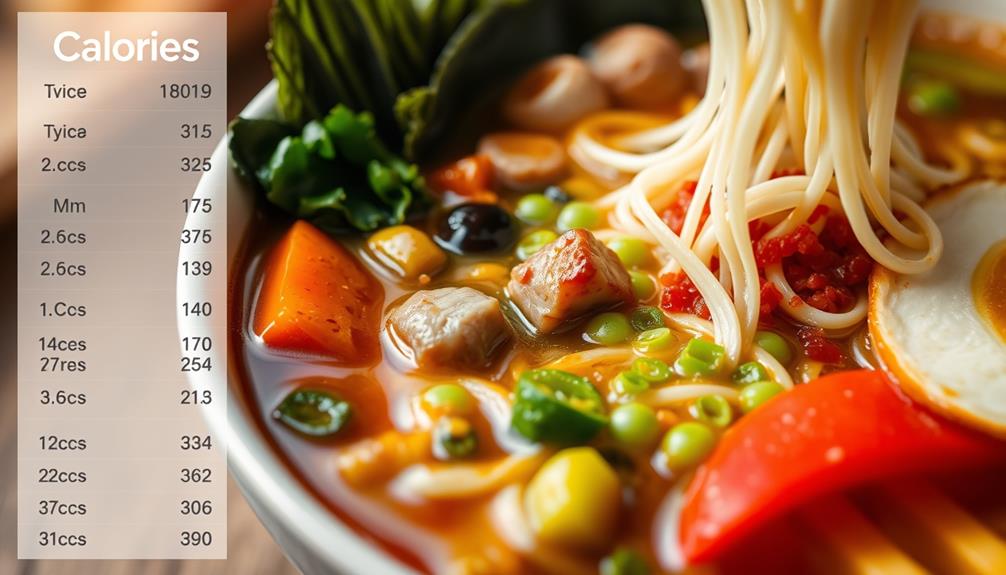
When you're digging into a bowl of ramen at a Japanese restaurant, it's good to know what you're getting regarding calories. The caloric content of ramen typically ranges between 450 to 600 calories, depending on how much soup you consume. The calorie breakdown reveals that ramen noodles contribute about 50% of the total calories, while the broth base accounts for around 35%, and toppings make up the remaining 15%.
To guarantee you're making informed dietary choices, consider how ramen fits into your overall nutrition plan, similar to the importance of selecting the right cold medication for effective relief.
The type of broth can greatly affect the overall calorie count. For instance, a rich, cloudy pork bone broth is more calorific than lighter options like transparent chicken or vegetable broth.
Also, keep in mind that a typical serving of ramen noodles weighs around 130 to 180 grams; boiling them can increase their weight and, consequently, the calorie intake.
If you're looking to enjoy ramen without overdoing it, consider consuming less than the entire bowl of soup. This simple adjustment can save you over 50 calories, helping you maintain a more moderate caloric intake while still savoring your dish.
Just be cautious; ramen often comes with high sodium levels too!
Understanding Ramen Noodles
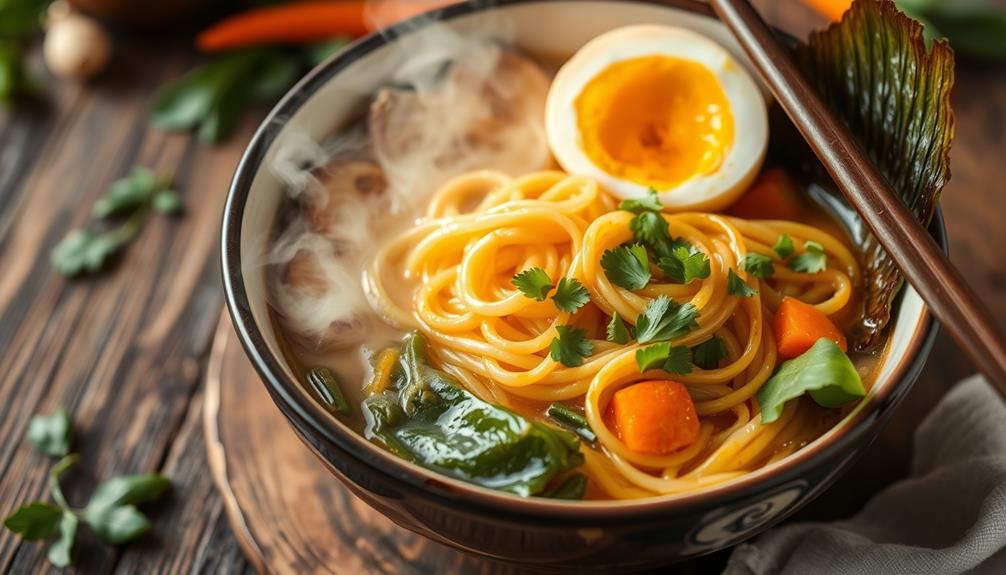
When you think about ramen noodles, it's important to understand their basic composition and nutritional value.
These noodles, typically made from wheat flour and kansui, pack a calorie punch but lack essential nutrients.
Different preparation methods can also influence the healthiness of the dish, similar to how various brewing methods affect coffee's nutritional content, such as caffeine levels in coffee.
As you explore the health implications of ramen, consider how these factors impact your overall diet.
Ramen Noodle Composition
Ramen noodles are often a staple in many diets, but understanding their composition is crucial for making informed choices. Ramen noodles are made from a mix of wheat flour, water, salt, and kansui, which gives them their unique texture and yellow hue. The variety in thickness and shape can depend on the type of broth you choose, ranging from thick and straight to thin and curly.
When considering the overall healthiness of ramen, it's important to look at their nutritional value. A typical serving of ramen noodles (around 81 grams) contains approximately 14 grams of total fat and 6.58 grams of saturated fat, with minimal fiber or essential vitamins and minerals. Instant ramen, while convenient, often has a high sodium content—around 1503 mg per serving, which is about 65% of your daily recommended intake.
Here's a quick comparison of ramen noodle types:
| Type of Ramen | Sodium Content (mg) |
|---|---|
| Traditional | Varies |
| Instant | ~1503 |
| Fresh | Lower than instant |
Be mindful of your choices when enjoying ramen!
Nutritional Value Overview
Understanding the nutritional value of ramen noodles is essential for making healthier meal choices. Ramen noodles primarily consist of wheat flour, water, salt, and kansui, which gives them their distinct texture and yellow color.
However, they come with a significant downside: a typical serving contains around 1503 mg of sodium. This high sodium content can contribute considerably to your daily intake limits, which is important to keep in mind. Regular consumption of high-sodium foods like ramen can lead to health issues such as hypertension and heart disease, making moderation vital.
While fresh ramen noodles, often enjoyed in Japan, may offer more nutrients and fiber, many instant varieties lack essential vitamins and minerals. You'll find that ramen noodles generally provide high carbohydrate content with minimal nutritional value.
This means they can spike your blood sugar levels, raising concerns for your overall health. For those mindful of their diets, exploring health considerations related to ramen can provide further insights.
Health Implications of Ramen
Many people enjoy ramen for its quick preparation and comforting taste, but it is crucial to contemplate the health implications associated with its consumption. Ramen, especially instant ramen, can lead to significant health concerns due to high sodium intake and low nutritional value. A single serving of ramen noodles can contain around 1503 mg of sodium, which is about 65% of your daily recommended intake. Regular consumption may increase the risk of metabolic syndrome and other health issues.
Here's a breakdown of the health implications:
| Health Concern | Details |
|---|---|
| High Sodium Intake | Can lead to hypertension |
| Low Nutritional Value | Lacks essential vitamins & minerals |
| Processed Ingredients | Linked to various health risks |
| Metabolic Syndrome Risk | Increased risk with frequent use |
While fresh ramen noodles might be a better option, they still fall short in providing the nutrients your body needs. Enjoying ramen occasionally is fine, but be mindful of how it can impact your health if consumed regularly. Prioritize a balanced diet and consider alternatives that offer more nutritional benefits.
Sodium Concerns in Ramen
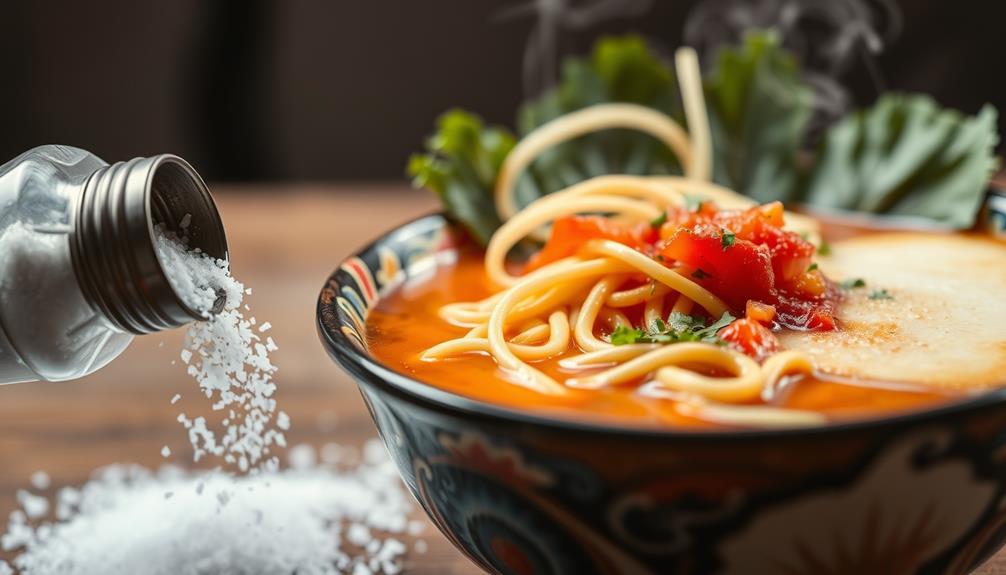
When you're enjoying a bowl of ramen, it's essential to take into account the sodium content. Many broths can pack over 1,760 mg of sodium per serving, pushing you close to the daily limit recommended by health organizations.
This high sodium level can contribute to various health issues, including high blood pressure and heart disease.
Thankfully, there are healthier alternatives out there if you want to enjoy ramen without the health risks, such as opting for lower-sodium broth or making your own at home for better budget management.
Sodium Content Concerns
Ramen can be a delicious meal, but its sodium content raises significant health concerns. Many ramen broths are loaded with sodium; some packages contain up to 1,760 mg per serving, which is a staggering 88% of the World Health Organization's daily limit.
Given that the average U.S. sodium intake is around 3,400 mg, you're likely exceeding the American Heart Association's recommendation of less than 2,300 mg daily if you indulge in ramen often. Financial considerations for elderly care are essential for those who may be at risk due to high sodium intake and its potential health impacts.
High sodium consumption is linked to serious health risks, including metabolic syndrome and hypertension.
While Japanese ramen culture doesn't typically focus on sodium concerns, the global recognition of its health effects, especially regarding cardiovascular health, is increasing. Regularly consuming ramen can lead to elevated blood pressure and a heightened risk of heart disease due to excess sodium intake.
Healthier Alternatives Available
Finding healthier alternatives to traditional ramen can considerably reduce sodium intake while still satisfying your cravings. Instead of the typical high-sodium broth that can exceed 1,760 mg per serving, opt for a low-sodium broth. This simple switch can considerably cut your sodium consumption while maintaining that comforting flavor you love.
Additionally, consider incorporating toppings such as fresh herbs or vegetables that are known for their health benefits, like essential oils for hair growth which can support overall wellness.
To boost the nutritional value of your ramen, load up on fresh vegetable toppings like spinach, mushrooms, or bok choy. Not only do these ingredients add flavor and texture, but they also provide essential vitamins and minerals.
You can also explore customization options available at many ramen restaurants. Don't hesitate to request less salty broth or ask for additional fiber-rich ingredients to create a more balanced meal.
Nutritional Value of Ramen
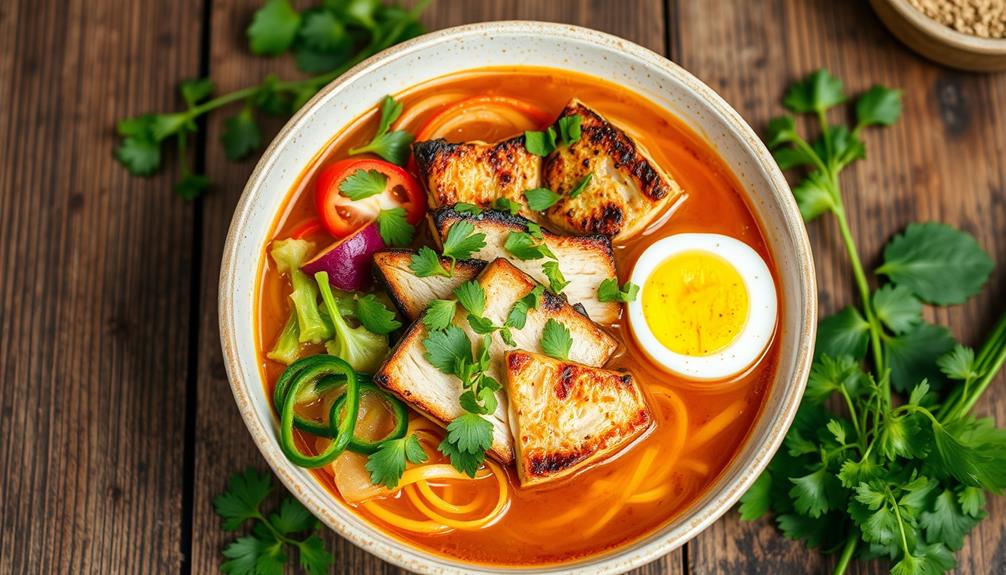
While enjoying a bowl of restaurant ramen, it's important to take into account its nutritional value, as it can vary widely based on the ingredients used. Typically, a serving of ramen contains between 450 to 600 calories, with most of the calories coming from the noodles (about 50%) and the soup (around 35%).
The broth plays a significant role in determining the nutritional value; for example, tonkotsu broth tends to be higher in calories and fat compared to lighter options like shoyu or shio. To optimize health, consider incorporating additional nutrients by choosing toppings wisely, as a balanced diet is essential for overall well-being effective strategies for weight loss.
Ramen noodles are generally low in fiber and protein, primarily delivering carbohydrates, with about 27 grams per 100 grams. However, the toppings can make a difference. Adding soft-boiled eggs, lean meats, and vegetables can enhance the nutritional profile, providing extra protein, vitamins, and minerals.
Keep in mind that moderation is key. Excessive consumption of ramen, especially those with high-sodium broths, can lead to health issues like high blood pressure and increased risk of metabolic syndrome.
Ramen vs. Fast Food
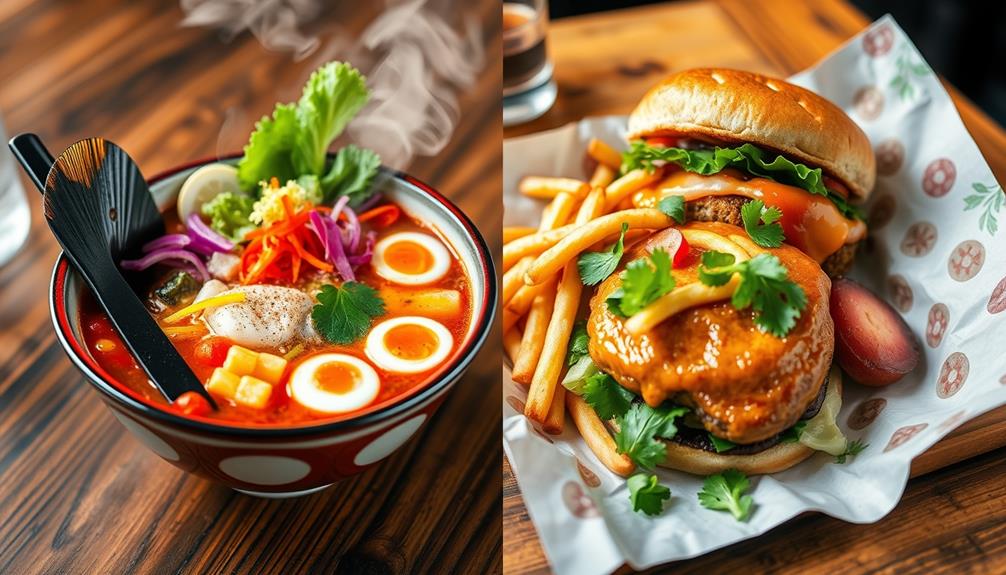
When comparing ramen to fast food, you'll often find that ramen can offer a healthier alternative. Traditional Japanese ramen typically contains between 450-600 calories, which is lower than many fast food meals that can exceed 700 calories.
Unlike fast food, often served with high-fat sides like fries, ramen focuses primarily on its broth and noodles. Additionally, the emotional aspects of eating, such as comfort and craving, can influence choices, similar to how individuals with BPD may have unstable relationships with food.
While some ramen styles, like Tonkotsu, may be perceived as greasy, lighter options are more common in Japan and generally offer a healthier profile. Fast food items are often high in added sugars and unhealthy fats, while the primary calorie source in ramen comes from noodles, which usually have lower sugar content.
Additionally, ramen's nutritional value is enhanced by the inclusion of protein and vegetables, making it a better choice compared to standard fast food options that often lack these essential nutrients.
However, be mindful that some ramen can be high in sodium. Overall, when you're looking for a satisfying meal, ramen can be a balanced option that provides more nutrition than typical fast food offerings.
Enhancing Ramen With Vegetables
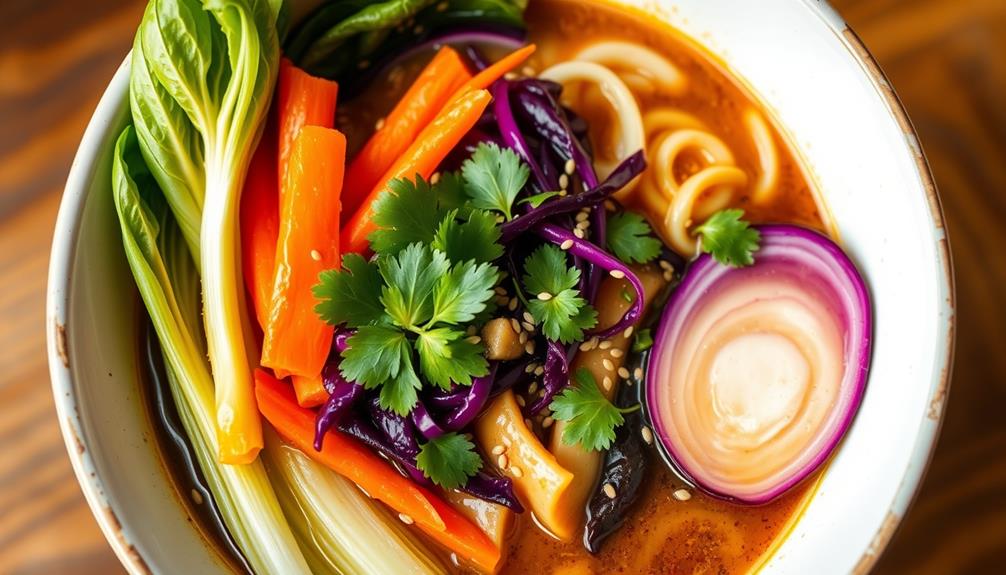
Ramen's versatility makes it easy to enhance its nutritional profile by incorporating a variety of vegetables. By adding vegetables like green onions, carrots, and spinach, you can greatly boost the nutritional value of your ramen. These additions not only elevate flavor but also provide essential vitamins and minerals that contribute to a healthier dish.
Including toppings like healthy dog snacks can also inspire creative flavor combinations. Consider incorporating toppings such as bamboo shoots and mushrooms. These not only enrich your ramen options but also help create a more balanced meal by offering additional nutrients.
The fiber content of your ramen can increase from about 1 gram to approximately 2.5 grams per serving with these vegetable additions, promoting a feeling of fullness and improving overall meal satisfaction. This can reduce the likelihood of overconsumption, making your dining experience more mindful.
Pairing vegetables with proteins like chicken or tofu can further enhance the healthiness of your ramen dish. Together, these ingredients contribute to a nutritious and satisfying meal, transforming your bowl of ramen into a wholesome option that you can enjoy guilt-free.
Health Risks of Instant Ramen
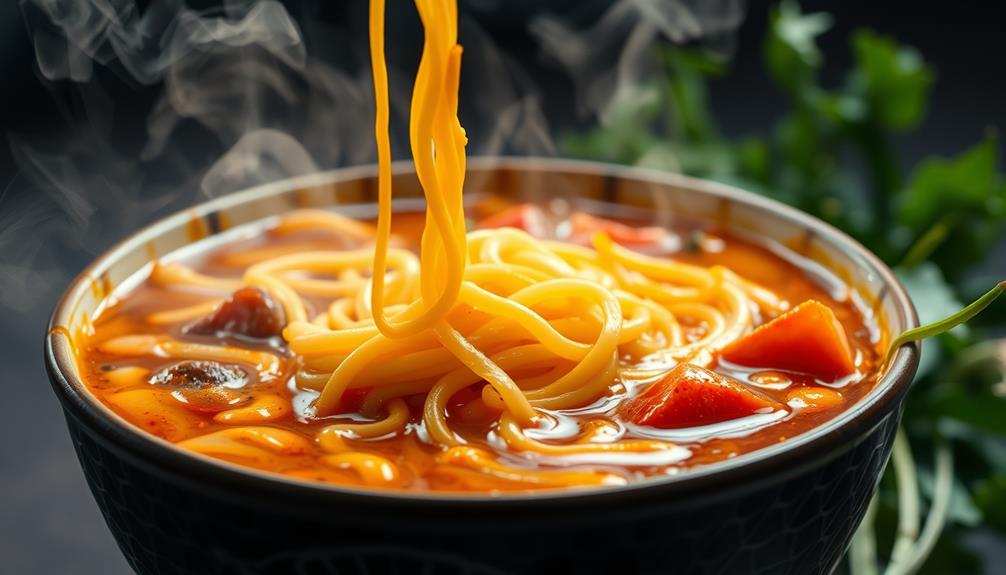
Eating instant ramen regularly can pose significant health risks. These convenient meals often contain instant ramen noodles that are alarmingly high in sodium—up to 1,760 mg per package. That's about 88% of the World Health Organization's recommended daily limit!
Additionally, many seniors experience unique dietary challenges, making it essential for caregivers to understand nutritional needs and encourage healthier meal options, such as those found in financial considerations for elderly care. When you consume instant ramen more than twice a week, you increase your risk of developing metabolic syndrome by 68%. This syndrome includes serious conditions like obesity and high blood pressure, both of which can lead to further complications.
Moreover, instant ramen noodles are typically low in nutritional value. While they might provide a quick source of calories, they lack essential vitamins, minerals, and high-quality protein.
The excessive sodium intake from these noodles can elevate your risk of heart disease and high blood pressure, especially if you already have pre-existing health conditions. The highly processed nature of instant ramen contributes to these health risks, as the ingredients may lead to long-term issues like diabetes and cardiovascular diseases.
Ultimately, while instant ramen may satisfy hunger in the short term, its regular consumption can have lasting negative effects on your health.
Ramen During Pregnancy
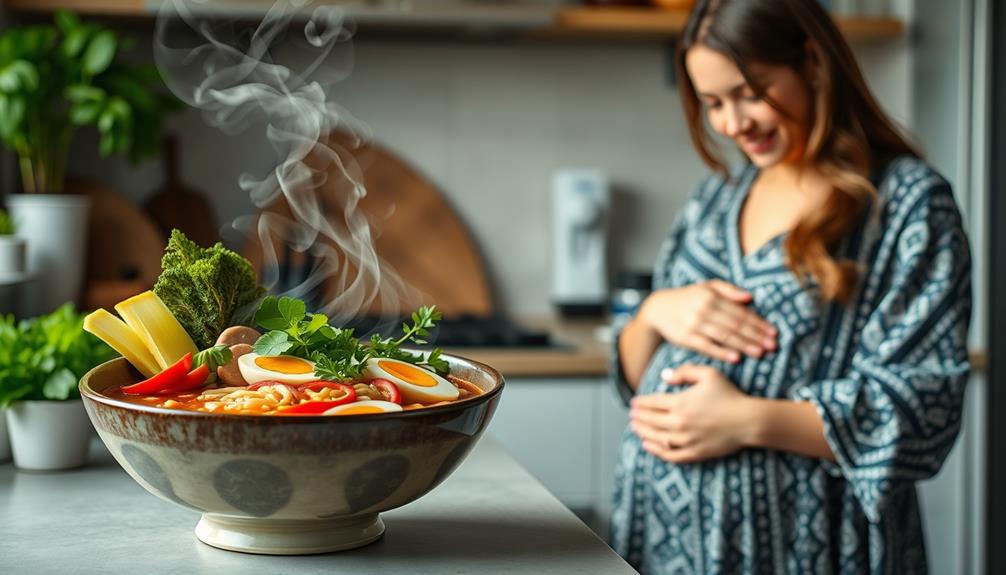
While instant ramen presents health risks for regular consumption, enjoying ramen during pregnancy can be a safe option if you choose your ingredients wisely.
It's important to verify that the broth is made from safe ingredients, as certain nutritional benefits can enhance the overall healthiness of the dish. You'll want to pay close attention to ingredient safety, especially when it comes to toppings. Avoid raw fish and bean sprouts, as these can pose foodborne illness risks. Instead, opt for protein options like beef or shredded chicken, which are safer choices during this time.
When making ramen during pregnancy, consider the broth types you use. Chicken or shoyu broth not only enhances flavor but also provides a comforting base that prioritizes safety.
If you're up for it, using bone broth can add extra nutrients, supporting your health and your baby's development.
Mindful ingredient selection and proper preparation can verify you enjoy this delicious dish without compromising your well-being. Always prioritize high-quality ingredients, as this will help you savor the flavors while minimizing any potential risks.
Making Healthier Ramen Choices
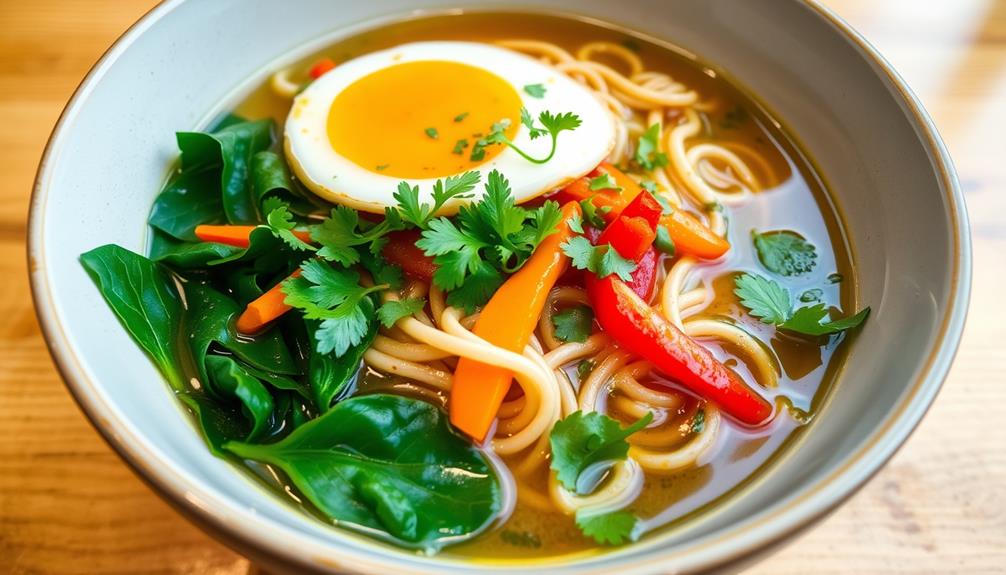
How can you enjoy ramen while making healthier choices? Start by selecting lighter broth varieties, like shoyu or shio, which usually have less fat and sodium than richer options like tonkotsu. This simple switch can greatly lower your sodium intake, making your meal healthier.
Next, pack your ramen with a variety of vegetables. Spinach, carrots, and green onions not only add flavor but also boost the nutritional value by increasing vitamins, minerals, and fiber content.
Don't forget to add lean proteins like shredded chicken, tofu, or soft-boiled eggs. These options provide essential nutrients without piling on excess fat, balancing your meal nicely.
Be mindful of portion sizes, too. Consider using less broth or opting for smaller noodle portions to help reduce overall calorie and sodium intake.
Frequently Asked Questions
Is Restaurant Ramen Noodles Healthy?
Restaurant ramen noodles aren't particularly healthy due to their high calorie and sodium content. However, if you choose lighter options and add plenty of vegetables and lean proteins, you can enjoy a more balanced meal. You can also make your own ramen at home using whole wheat or zucchini noodles for a healthier alternative. Additionally, using a little bit of oil while cooking the noodles can help in preventing pasta from sticking together. By making these small adjustments, you can still enjoy delicious ramen without sacrificing your health.
How Many Calories Are in a Restaurant Ramen?
Like a warm embrace, restaurant ramen packs between 450 to 600 calories. The noodles, soup, and toppings dance together, creating a hearty meal. By opting for lighter broth, you can trim those calories down.
What Is the Healthiest Type of Ramen?
When considering the healthiest type of ramen, opt for shoyu or shio ramen. They're typically lighter, lower in calories, and when topped with vegetables and lean proteins, they enhance both flavor and nutritional value.
Is Restaurant Ramen High in Cholesterol?
Yes, restaurant ramen can be high in cholesterol, especially those with rich broths and fatty toppings. If you're concerned about cholesterol, consider lighter broth options and vegetable toppings to make a healthier choice.
Conclusion
In the end, enjoying ramen can be like savoring a warm hug on a cold day—comforting but not always the healthiest choice. Remember, a typical instant ramen pack can pack over 1,500 milligrams of sodium, nearly two-thirds of the recommended daily limit. By adding fresh veggies or lean proteins, you can turn that bowl of noodles into a nourishing meal. So, next time you crave ramen, think of it as a canvas—paint it with health!
